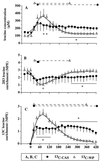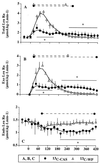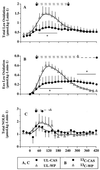Slow and fast dietary proteins differently modulate postprandial protein accretion - PubMed (original) (raw)
Slow and fast dietary proteins differently modulate postprandial protein accretion
Y Boirie et al. Proc Natl Acad Sci U S A. 1997.
Abstract
The speed of absorption of dietary amino acids by the gut varies according to the type of ingested dietary protein. This could affect postprandial protein synthesis, breakdown, and deposition. To test this hypothesis, two intrinsically 13C-leucine-labeled milk proteins, casein (CAS) and whey protein (WP), of different physicochemical properties were ingested as one single meal by healthy adults. Postprandial whole body leucine kinetics were assessed by using a dual tracer methodology. WP induced a dramatic but short increase of plasma amino acids. CAS induced a prolonged plateau of moderate hyperaminoacidemia, probably because of a slow gastric emptying. Whole body protein breakdown was inhibited by 34% after CAS ingestion but not after WP ingestion. Postprandial protein synthesis was stimulated by 68% with the WP meal and to a lesser extent (+31%) with the CAS meal. Postprandial whole body leucine oxidation over 7 h was lower with CAS (272 +/- 91 micromol.kg-1) than with WP (373 +/- 56 micromol.kg-1). Leucine intake was identical in both meals (380 micromol.kg-1). Therefore, net leucine balance over the 7 h after the meal was more positive with CAS than with WP (P < 0.05, WP vs. CAS). In conclusion, the speed of protein digestion and amino acid absorption from the gut has a major effect on whole body protein anabolism after one single meal. By analogy with carbohydrate metabolism, slow and fast proteins modulate the postprandial metabolic response, a concept to be applied to wasting situations.
Figures
Figure 1
Protocol design of the different studies with the labeled (13C-WP and 13C-CAS studies) and unlabeled (UL-WP and UL-CAS studies) milk protein fractions.
Figure 2
(A) Plasma leucine concentrations, (B) enrichments of the i.v. infused 2H3 tracer, and (C) enrichments of the orally administered 13C tracer, after a labeled WP meal (13C-WP study) and a CAS meal (13C-CAS study). ∗, Statistical differences between the two protein meals (P < 0.05). The dashed lines at the top of each panel indicate a significant difference from baseline (P < 0.05) within each study.
Figure 3
(A) Total leucine rate of appearance, (B) exogenous leucine rate of appearance, and (C) endogenous leucine rate of appearance after labeled WP ingestion (13C-WP study; open triangles) and labeled CAS ingestion (13C-CAS study; closed circles). ∗, Statistical differences between the two protein meals (P < 0.05). The dashed lines at the top of each panel indicate a significant difference from baseline (P < 0.05) within each study.
Figure 4
(A) Total leucine oxidation after unlabeled milk protein ingestion (UL-WP and UL-CAS studies), (B) exogenous leucine oxidation after labeled protein ingestion (13C-WP, open triangles; 13C-CAS, closed circles), (C) and Total NOLD (i.e., protein synthesis) from UL-WP and UL-CAS studies. ∗, Statistical differences between the two protein meals (P < 0.05). The dashed lines at the top of each panel indicate a significant difference from baseline (P < 0.05) within each study.
Similar articles
- The digestion rate of protein is an independent regulating factor of postprandial protein retention.
Dangin M, Boirie Y, Garcia-Rodenas C, Gachon P, Fauquant J, Callier P, Ballèvre O, Beaufrère B. Dangin M, et al. Am J Physiol Endocrinol Metab. 2001 Feb;280(2):E340-8. doi: 10.1152/ajpendo.2001.280.2.E340. Am J Physiol Endocrinol Metab. 2001. PMID: 11158939 - The rate of protein digestion affects protein gain differently during aging in humans.
Dangin M, Guillet C, Garcia-Rodenas C, Gachon P, Bouteloup-Demange C, Reiffers-Magnani K, Fauquant J, Ballèvre O, Beaufrère B. Dangin M, et al. J Physiol. 2003 Jun 1;549(Pt 2):635-44. doi: 10.1113/jphysiol.2002.036897. Epub 2003 Mar 28. J Physiol. 2003. PMID: 12665610 Free PMC article. - Ingestion of Casein in a Milk Matrix Modulates Dietary Protein Digestion and Absorption Kinetics but Does Not Modulate Postprandial Muscle Protein Synthesis in Older Men.
Churchward-Venne TA, Snijders T, Linkens AM, Hamer HM, van Kranenburg J, van Loon LJ. Churchward-Venne TA, et al. J Nutr. 2015 Jul;145(7):1438-45. doi: 10.3945/jn.115.213710. Epub 2015 May 27. J Nutr. 2015. PMID: 26019248 Clinical Trial. - Influence of the protein digestion rate on protein turnover in young and elderly subjects.
Dangin M, Boirie Y, Guillet C, Beaufrère B. Dangin M, et al. J Nutr. 2002 Oct;132(10):3228S-33S. doi: 10.1093/jn/131.10.3228S. J Nutr. 2002. PMID: 12368423 Review. - Milk proteins: Processing, gastric coagulation, amino acid availability and muscle protein synthesis.
Horstman AMH, Huppertz T. Horstman AMH, et al. Crit Rev Food Sci Nutr. 2023;63(30):10267-10282. doi: 10.1080/10408398.2022.2078782. Epub 2022 May 25. Crit Rev Food Sci Nutr. 2023. PMID: 35611879 Review.
Cited by
- Pea proteins oral supplementation promotes muscle thickness gains during resistance training: a double-blind, randomized, Placebo-controlled clinical trial vs. Whey protein.
Babault N, Païzis C, Deley G, Guérin-Deremaux L, Saniez MH, Lefranc-Millot C, Allaert FA. Babault N, et al. J Int Soc Sports Nutr. 2015 Jan 21;12(1):3. doi: 10.1186/s12970-014-0064-5. eCollection 2015. J Int Soc Sports Nutr. 2015. PMID: 25628520 Free PMC article. - Protein Source and Muscle Health in Older Adults: A Literature Review.
Putra C, Konow N, Gage M, York CG, Mangano KM. Putra C, et al. Nutrients. 2021 Feb 26;13(3):743. doi: 10.3390/nu13030743. Nutrients. 2021. PMID: 33652669 Free PMC article. Review. - Commentary: Greek Yogurt and 12 Weeks of Exercise Training on Strength, Muscle Thickness and Body Composition in Lean, Untrained, University-Aged Males.
Jakobsson J. Jakobsson J. Front Nutr. 2019 Sep 10;6:137. doi: 10.3389/fnut.2019.00137. eCollection 2019. Front Nutr. 2019. PMID: 31552258 Free PMC article. No abstract available. - Feeding intact proteins, peptides, or free amino acids to monogastric farm animals.
Eugenio FA, van Milgen J, Duperray J, Sergheraert R, Le Floc'h N. Eugenio FA, et al. Amino Acids. 2022 Feb;54(2):157-168. doi: 10.1007/s00726-021-03118-0. Epub 2022 Feb 1. Amino Acids. 2022. PMID: 35106634 Review. - Plasma Amino Acid Concentrations After the Ingestion of Dairy and Collagen Proteins, in Healthy Active Males.
Alcock RD, Shaw GC, Tee N, Burke LM. Alcock RD, et al. Front Nutr. 2019 Oct 15;6:163. doi: 10.3389/fnut.2019.00163. eCollection 2019. Front Nutr. 2019. PMID: 31681789 Free PMC article.
References
- Jenkins D J A, Wolever T M S, Taylor R H, Barker H, Fielden H, Baldwin J M, Bowling A C, Newman H C, Jenkins A L, Goff D U. Am J Clin Nutr. 1981;34:362–366. - PubMed
- Motil K J, Matthews D E, Bier D M, Burke J F, Munro H N, Young V R. Am J Physiol. 1981;240:E712–E721. - PubMed
- Beaufrère B, Horber F, Schwenk F, Marsh H, Haymond M W. Am J Physiol. 1989;257:E712–E721. - PubMed
- Melville S, Nurlan M A M, Hardy K C M, Broom J, Milne E, Calder A G, Garlick P J. Metabolism. 1989;38:248–255. - PubMed
- Pacy P J, Price G M, Halliday D, Millward D J. Clin Sci. 1994;86:103–118. - PubMed
Publication types
MeSH terms
Substances
LinkOut - more resources
Full Text Sources
Other Literature Sources
Medical



